Science
Related: About this forumA Nice Discussion by Indonesian Scientists on Aspects of Proliferation Resistant Plutonium.
Nuclear Science, like all science, is or should be international. I was very pleased to uncover this paper, which apparently I downloaded back in 2022 but did not get around to opening until this morning, going through my backfiles, on proliferation resistant plutonium from fast breeder reactors written by Indonesian scientists:
Sidik Permana, Analysis on different material attractiveness concept based on plutonium composition of FBR blanket system, Progress in Nuclear Energy, Volume 127, 2020, 103404
(The World Nuclear Association describes Indonesia as having "a greater depth of experience and infrastructure in nuclear technology than any other country in southeast Asia." Currently, Indonesia lacks commercial nuclear power reactors, and is heavily reliant on coal power, described, again by the World Nuclear Association on the linked page as follows: Generation mix: coal 189.7 TWh (61%); natural gas 51.6 TWh (17%); hydro 24.7 TWh (8%); biofuels & waste 17.4 TWh (6%); geothermal 15.9 TWh (5%); oil 8.7 TWh (3%); wind 0.4 TWh.)
To save what is left to save, and restore that which can be restored (which grows smaller by the hour), we must have plutonium in my view. With plutonium production, using the uranium already mined (as well as the dumped thorium generated by mining lanthanides for so called "renewable energy" ) we can eliminate all needs for energy mining for centuries according to my calculations. With the exception of CANDU type heavy water reactors, and then only with the inclusion of thorium in the fuel, plutonium is only accessible with full utilization of uranium resources in the fast neutron spectrum.
Indonesia, again, doesn't have commercial reactors, but it is nice to see the scientific community there engaged in forward thinking about how, why and where to get plutonium which is not usable in nuclear weapons. This is especially important, since obviously insane people, including the orange slime in the White House, can and do have access to these weapons. The path, in the current age of insanity still a pipe dream, to nuclear weapons disarmament goes through nuclear reactors. (Al Gore, a very sane person, as VP, was actively engaged in this process in the 1990's working with the then Russian government.)
If I recall correctly, I may have discussed this topic of proliferation resistance previously at DU; I have also covered it on other websites. On Plutonium, Nuclear War, and Nuclear Peace
The ideas around the paper are not necessarily new, but all such discussions, as they offer refinements in thinking on the topic, are valuable and worthy of consideration.
Some nice commentary from the paper:
Material attractiveness concepts for evaluating the level of proliferation resistance of nuclear fuel have been progressively developed and become one of the hot issues especially for anticipating the use of nuclear material for explosive devices by some nations or sub-nation or groups. Adopting some criteria for estimating the proliferation level of nuclear fuel compositions will gives the early signal for preventing the use of nuclear fuel not for peaceful use especially for plutonium as attractive material from recycled spent fuel. Level of isotopic barrier can be adopted as a criterion for proliferation resistance level at all processes since the mining, fabrication, the beginning of reactor operation up to end of operation, reprocessing processes from FBR spent fuel until refueling for fresh fuel, all those processes should be protected. In case of plutonium, isotopic plutonium barrier which is based on the material barrier of even mass number (Pu-238, Pu-240 and Pu-242) in regards to their high decay heat (DH) and spontaneous neutron fission (SFN) can be adopted for evaluating the intrinsic proliferation resistance...
The point is that that excess neutrons from spontaneous fission can lead to premature detonation of a nuclear weapon, known as a "fizzle" which limits the size and effects of a nuclear explosion, if one takes place at all. (At least one North Korean nuclear test is known to have represented a "fizzle." ) It is also known that alpha decay effects the phase dynamics of plutonium, leading to voids, and this effects the effective lifetime of a bomb core. Concern about this issue delayed the abandonment of nuclear weapons testing.
The authors define a parameter they call "attractiveness," which is a function of explosive yield and the difficulty of assembling a nuclear weapon with a particular "plutonium vector" which is simply a vector composed of the concentration of the readily accessible isotopes of plutonium in a particular metal sample. The accessible isotopes are 238Pu, a heat generating isotope utilized in deep space robotic missions such as the Voyager craft, 239Pu, which in high isotopic purity is the isotope used in nuclear weapons, 240Pu, a source of spontaneous fission neutrons, 241Pu, the parent of the minor actinide americium's important isotope 241Am, and also a highly fissionable, if short lived (t1/2 = 14.29 years) isotope, and 242Pu a source of spontaneous fission neutrons.
They offer an empirical "formula" for "attractiveness defined elsewhere: "
Material attractiveness analysis of plutonium has been evaluated based on the attractiveness (ATTR) concept (Saito et al., 2008) as the first material attractiveness formula for this evaluation. The ATTR concept is mainly based on the sensitive parameters of Rossi-alpha, decay heat compositions and spontaneous fission neutron (SFN). Basic concept of ATTR for evaluating the material attractiveness level is derived from the ratio of probability of explosive energy from fissionable material and the technical difficulties which comes from the difficulties of handling, fabricate and others aspects because of the high difficulties of physical properties as well as chemical properties and so on of some nuclear material it's self naturally as shown in Equation (5).

Another parameter discussed in the paper is the "figure of merit: "
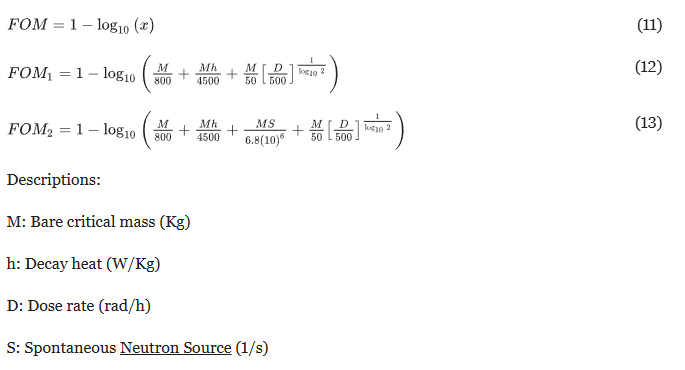
Some figures from the paper:
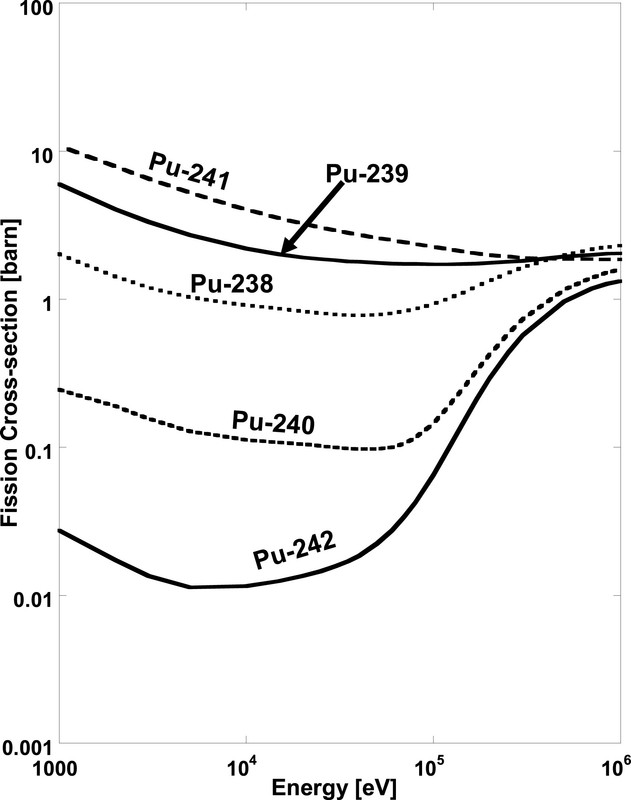
The caption:
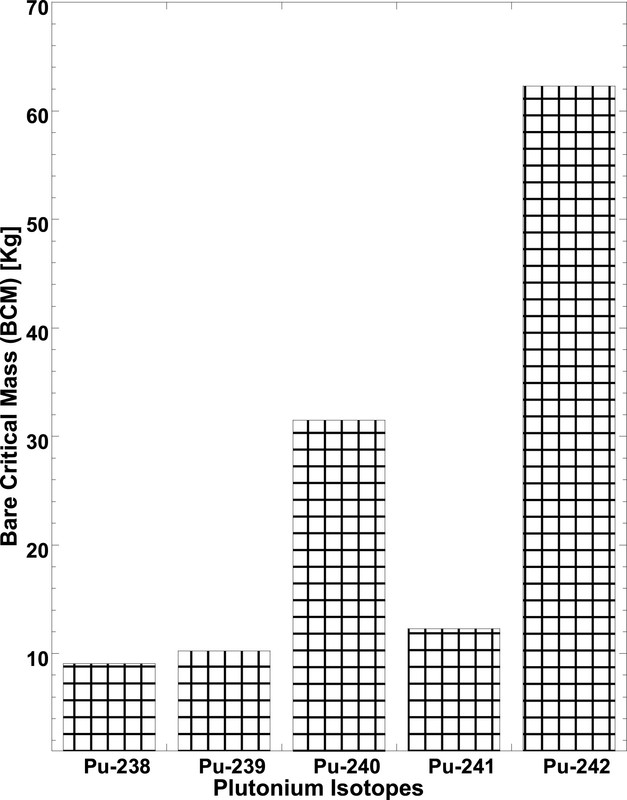
The caption:
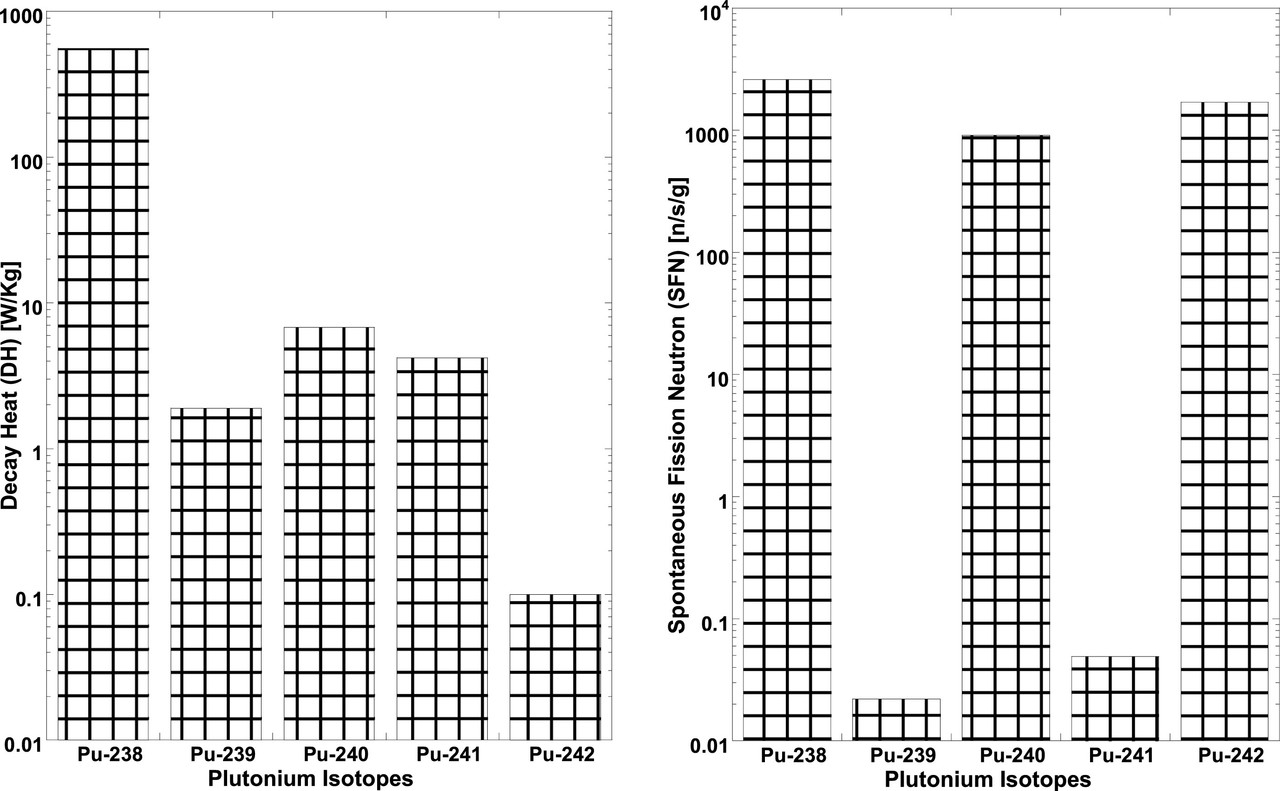
The caption:
Decay heat is important, since it effects the stability of the chemical explosives that are designed to induce compression in plutonium to induce supercriticality.
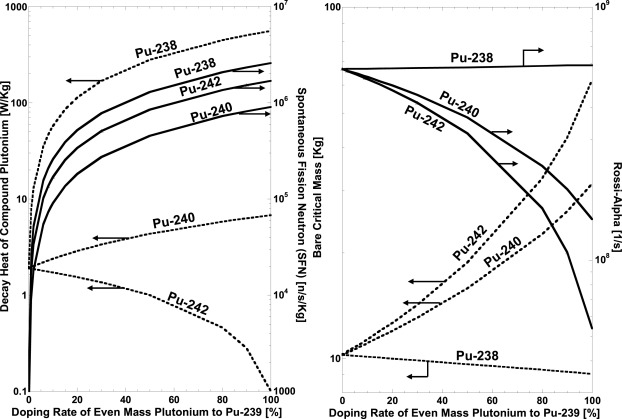
The caption:
Fig. 5. Proliferation resistance parameters of doping even mass plutonium to Pu-239.
Rossi alpha is parameter developed during the Manhattan Project to measure the ratio of delayed neutrons as opposed to prompt neutrons. Prompt neutrons are those that control access to supercritical states found in nuclear weapons.
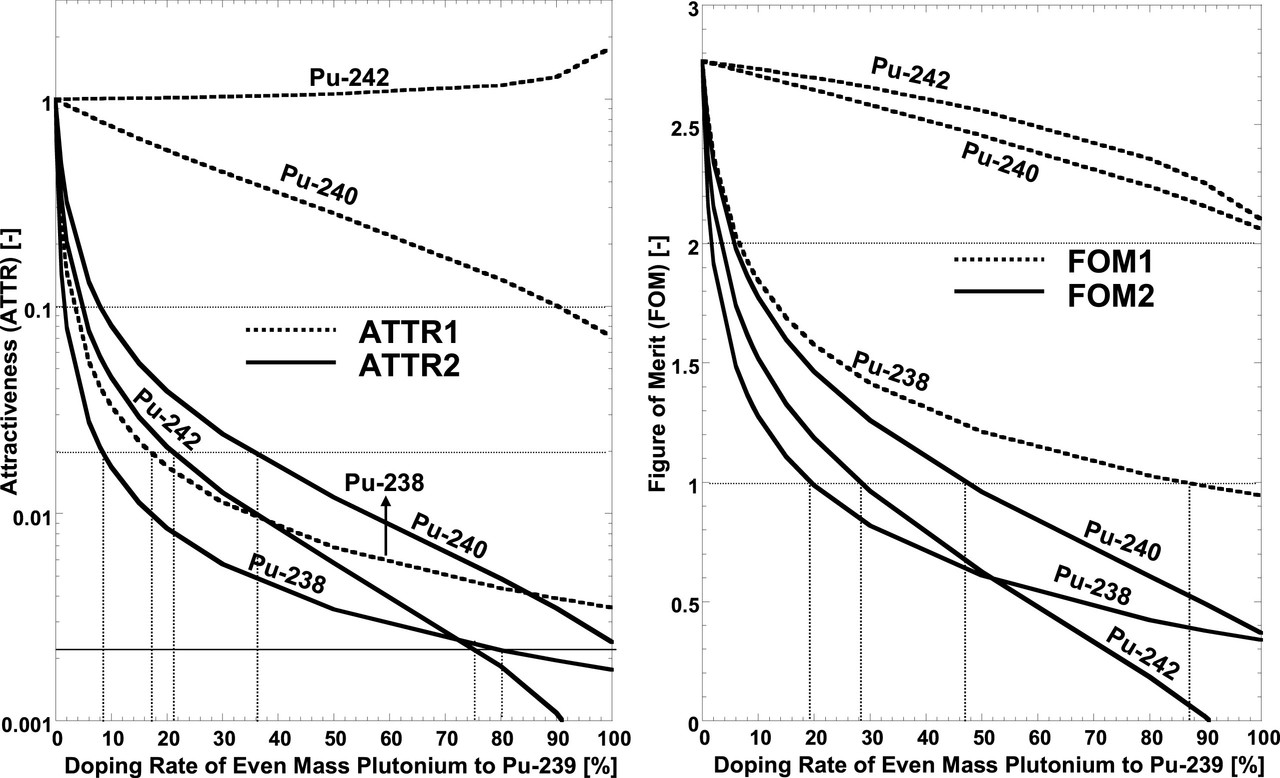
The caption:
The authors define "attractiveness" as follows:
1.
ATTR greater than 0.1: Weapon grade level
2.
0.02less than ATTRless than 0.1: Practically usable
3.
0.002less than ATTRless than 0.02: Practically unusable
4.
ATTRless than 0.002: Exempt
Figure of merit (FOM) concept for material attractiveness level:
1.
FOM greater than 2: High attractiveness level (Preferred)
2.
1 less than FOM less than 2: Medium attractiveness level (Attractive)
3.
0 less than FOM less than 1: Low attractiveness level (Unattractive)
4.
FOM less than 0: Very low attractiveness level (Unattractive)
(In the above text the mathematical symbols for "less than" and "more than" have been replaced with text to avoid complications with the DU editor that the symbols create.)
The following graphic refers to the "no doping" case where the fertile fuel is pure 238U, so called "depleted uranium." The most important plutonium isotope for denaturing the element is the heat generating isotope 238Pu, which is the fuel for deep space missions by virtue of its heat output. The point is the following graphic makes the point that this isotope will not be generated without long irradiation times, long enough for the accumulation of sufficient 242Cm (curium) that decays into 238Pu. In order to accelerate the accumulation of 238Pu it is useful to incorporate the minor actinides 237Np, and the 241Am (which will always be present with 243Am.
I have recently discussed the minor actinide americium, as a neat fuel in this space, which is not to say that my discussion represents the best use of americium, particularly in light of the delayed neutron issue:
Some Aspects of the Use of Americium as a Nuclear Fuel The point is that americium is valuable and should not, must not, be treated as waste. Here is a consequence of not using uranium while still trying to recover the enormous energy value of depleted uranium by transmutation into plutonium:
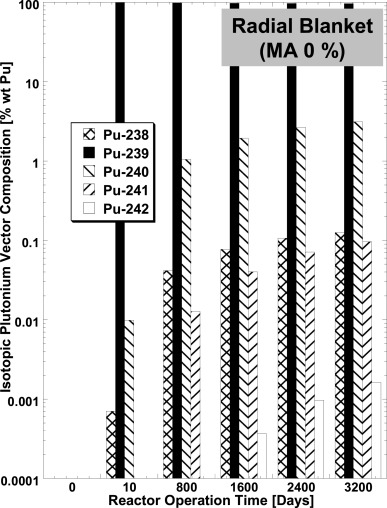
The caption:
I'm skipping some diagrams and discussion to get to the operative text in which minor actinide doping is employed:
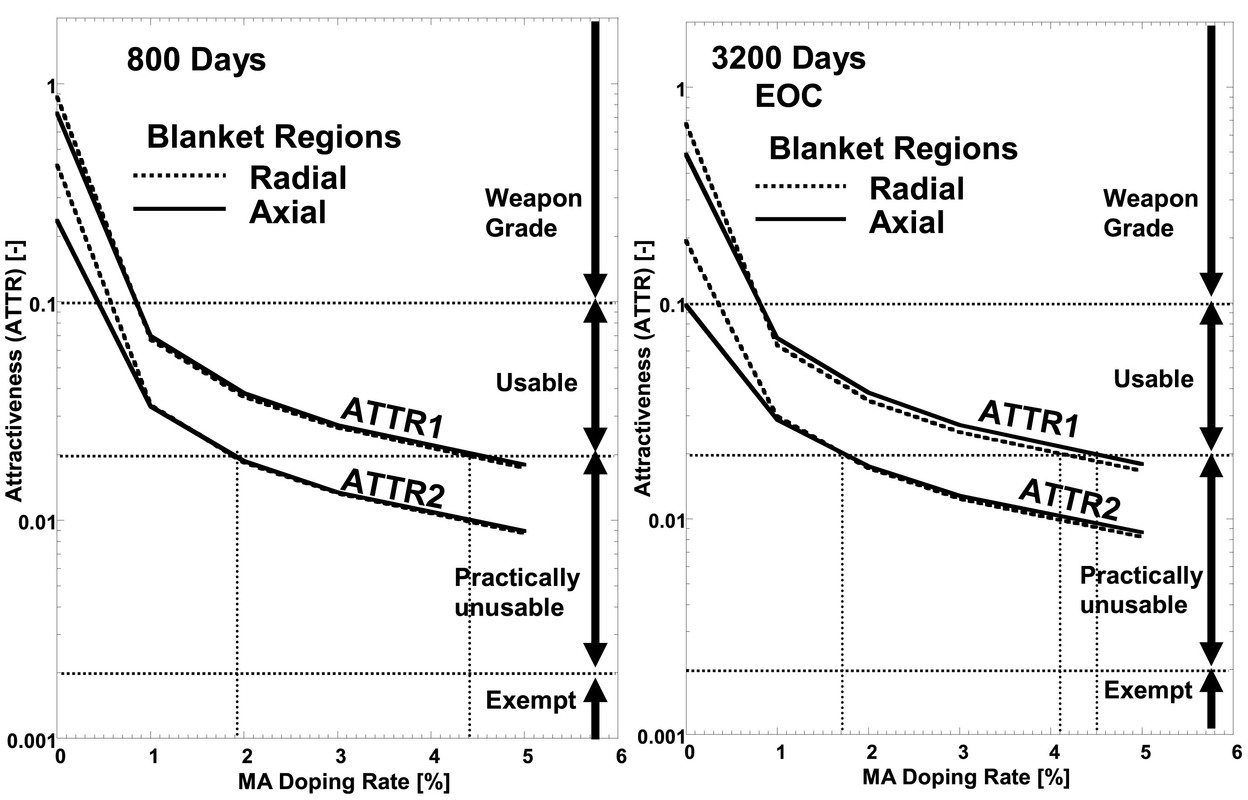
The caption:
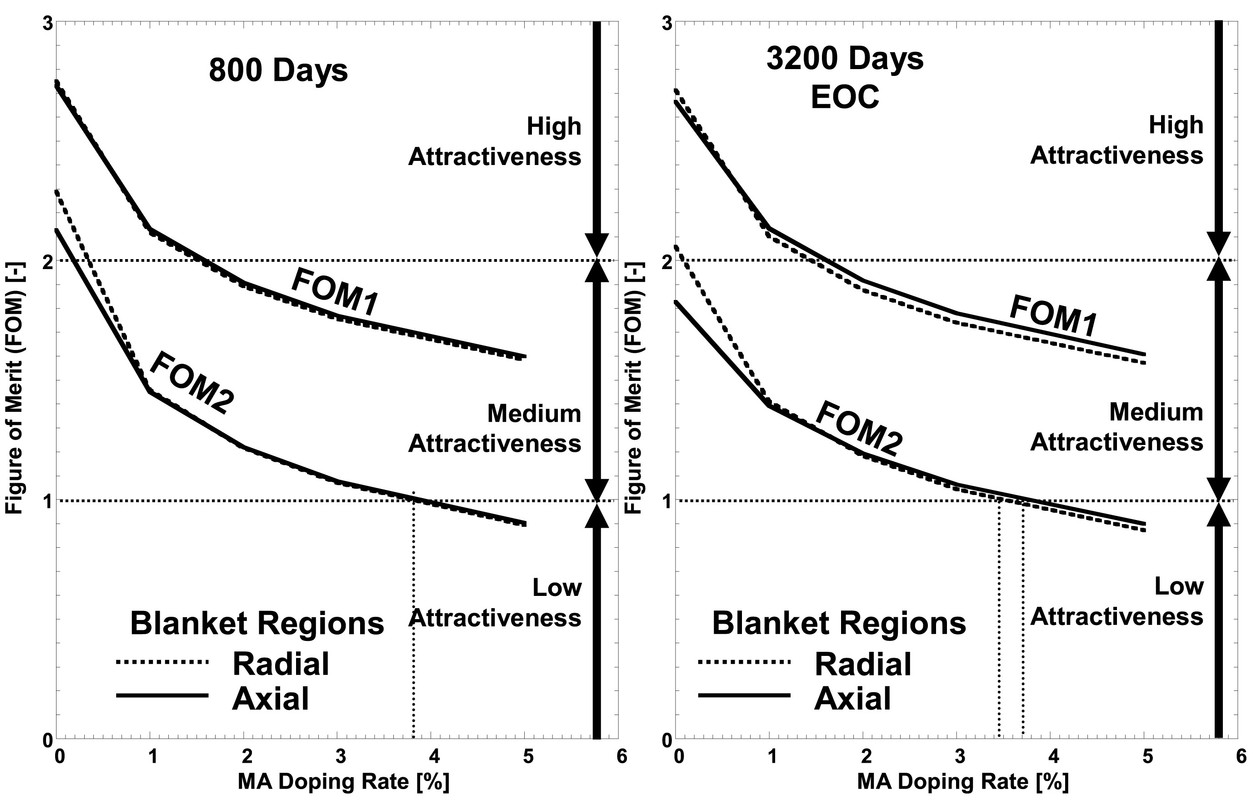
The caption:
Nuclear energy, which I argue is the last, best hope of the human race has always occupied a ridiculously special place in the public imagination and not in the positive way it deserves and, in fact, needs if we are to survive. People carry on endlessly about the risks of nuclear war, even more absurdly, "nuclear terrorism" and so called "nuclear waste," although the fossil fuel case of use in war, terrorism and waste is an observed set of problems, the last of which, fossil fuel waste expressed as extreme global heating is literally killing the planet. No one gives a shit about how many people die from fossil fuels diverted to make active weapons of mass destruction, nor that the destruction of the World Trade Center in New York was the result of fossil fuel terrorists using fossil fuel devices to kill people, and arguably, several nations because of their concerns about fossil fuel culture, Western influence in the Middle East. Nuclear war has not killed a single person since 1945, nearly 80 years ago, so called "nuclear waste" (which I personally regard as a nuclear resource) hasn't killed in the 70 year history of its accumulation as fossil fuel waste will kill in the next six hours, and nuclear terrorism is not observed on any scale that matters. (Putin killed a spy with nuclear materials, representing the only example of which I can think.)
It is obviously not possible, has never been possible, to prevent nuclear war, since uranium exists; nuclear war has always been possible since it has been observed, once, to end a fossil fuel war, driven, especially in the Japanese case, and also in the Soviet-German case, by a desire to control oil reserves. That is unambiguously true.
However, it is possible to minimize the probability of nuclear war as is described by these Indonesian scientist.
It is nice to see this work out of Indonesia, a coal dependent nation as of now with a population of around 280 million people, compared to the American population of 340 million.
The United States is clearly precipitously collapsing under the weight of its own stupidity, but clearly the world does not need us to go on without us as these Indonesians show.
I, for one, find that reassuring.
Have a nice weekend.
John ONeill
(78 posts)I read John A MacPhee's book, 'The Curve of Binding Energy', a long while back. He describes visiting nuclear plants with Ted Taylor, former Los Alamos bomb designer, and also going around the World Trade Centre, where Taylor vividly described the damage a satchel nuke could do. (It turned out, a few years later, to be be rather less than a few Saudis with box cutters and two planeloads of jet fuel could wreak.) Taylor had developed the smallest fission bombs ever made, using tritium boosting and beryllium cladding. He later became a strong proponent for increased vigilance over nuclear materials.
In New Zealand, our government in the 80s rejected the US nuclear umbrella, effectively being frozen out of the US - Australia - New Zealand ANZUS defence pact, but we had the luxury of being about one earth radius away from any potential threat. Now that America is proving an unreliable partner, it's likely that countries without their own nuclear deterrent, or with allies so armed, will rapidly develop their own. Russia's treatment of Ukraine, and Israel's of Syria (and possibly Iran), are a powerful incentive, as were the deaths of Saddam Hussein and Gaddaffi for any worried dictator. Of course they wouldn't be using reactor grade plutonium, enrichment and small dedicated weapons production reactors are the obvious approach, if even North Korea can do it.
Hopefully the rollout of civil nuclear power can proceed unaffected, as higher burnup and new reactors make diversion even more implausible.
NNadir
(36,220 posts)I had rather hoped that the world would go in the opposite direction, the one being forged by Gore with the Yeltsin regime.
The nuclear weapons genie cannot be put back in the box; this has been true since 1945. People like Trump and Putin are of course, some of the worst human beings on the planet, and it's disconcerting to see psychopaths with access to nuclear weapons. Nevertheless this is the state of the world that we see now. The economic disruptions their idiocy will cause and are causing will make situation far worse.
The probability of a world nuclear war however, is somewhat less likely in my view, that planetary scale destruction from fossil fuel waste. The former is theory, the latter is observed. This is a huge difference.
If a better world is possible, weapons grade material worldwide will be isotopically denatured in it, as the paper in the OP (and many, many others) suggest. The key component from what I understand of bomb physics, is 238Pu, the more the better. Some people argue that 237Np is a weapons grade material, and I believe them, but it is the key to 238Pu supplies, which would, of course, reduce or minimize the inventory of 237Np.
An argument can be made that the presence of nuclear weapons has resulted in the absence of another world war, but irrespective of this argument, I am a strong believer in weapons disarmament.
What to do with nuclear materials has always been, and always will be, a moral choice. It is frightening to see the erosion of morality the world is now experiencing.